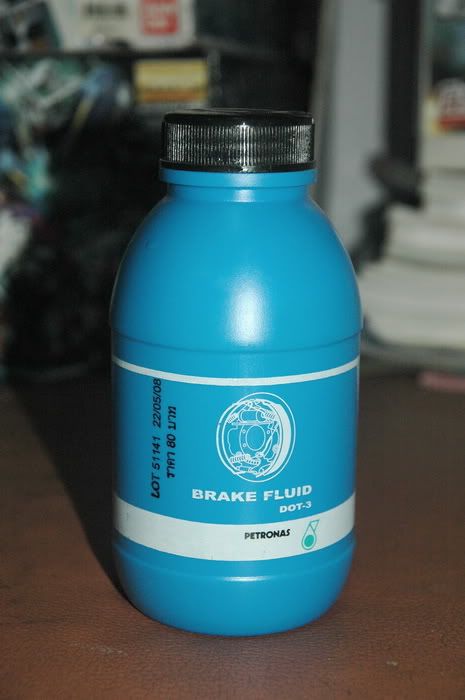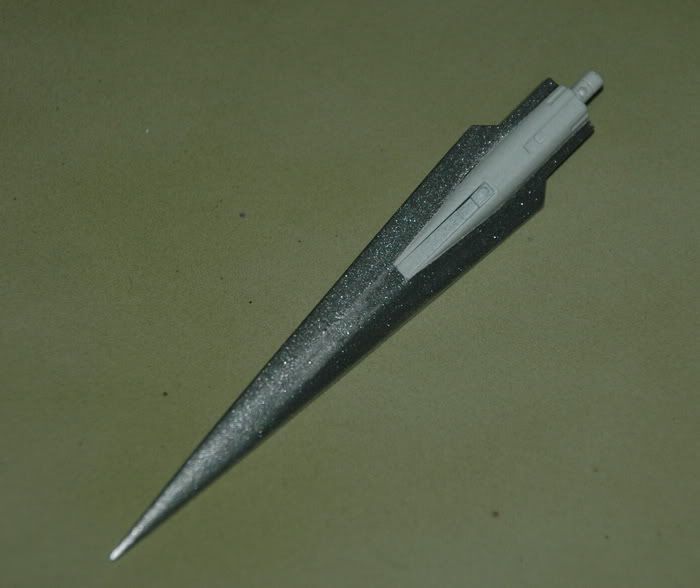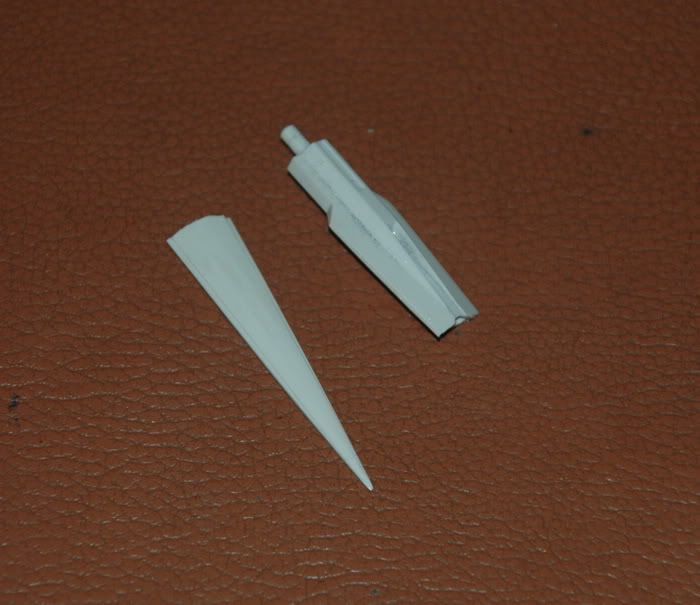เจ้าวัสดุชนิดนี้ผมเห็นครั้งแรกในเวบโมเดลของชาวญี่ปุ่น มีหลายเวบที่ใช้เจ้าวัสดุนี้ ทีแรกไม่รู้ว่ามันคืออะรได้วยซ้ำ
ว่ามันคืออะไร ลักษณะที่เห็นคือเป็นก้อนๆคล้ายดินน้ำมันใสๆบ้าง มีหลายสีบ้าง
บางทีก็โปะอยู่บนชิ้นงานที่จะทำการลอกแบบบางครั้งก็เห็นมีโพลีเอสเตอร์พุตตี้ที่เป็นชิ้นงานแล้วอยู่ด้านใน
บางครั้งก็เป็นเรซิ่นทั้งใสและทึบอยู่ในแม่พิมพ์ แต่ก็ยังไม่รู้ว่าเจ้าวัสดุปริศนานี่คืออะไรอยู่ดี งานที่เห็นบ่อยที่สุด
ก็คือก็อปหน้าเน็นด๋อยทั้งหลายนี่แหละ พอดีมีอยู่เวบหนึ่งเขาเอามาเจ้าวัสดุที่ว่านี้มาให้ดูทั้งห่อ เออแฮะ หน้าตาแบบนี้เอง
สีก็สวยดี แต่ก็ไม่รู้ว่าจะไปหซื้อมาจากที่ไหนอยู่ดี เพราะดูแล้วมันไม่น่าจะอยู่ในสาระบบของวัสดุและอุปกรณ์
ที่ขายในเวบทำโมเดลของบ้านเราเลย (ก็แหงละ มันเป็นสิ้นค้าที่เอาไว้ทำงานฝีมือเด็กสำหรับเด็กประถมนี่นา)
พอดีเมื่อเดือนที่แล้วผมไปที่ร้านไดโซะทุกอย่างราคาเดียว(เชียงใหม่นะ) ก็ไปเจอเจ้านี่โดยบังเอิญก็ซื้อมา1ซอง
โดยที่ผมก็ไม่แน่ใจว่าจะเป็นวัสดุแบบเดียวกันหรือเปล่า ซื้อมาก็วางเอาไว้กับกองโมเดลจนลืม
วันนี้เลยทำการทดสอบซะเลยครับ
มาดูเจ้าวัสดุลึกลับที่ว่ากันเลยครับ
เจ้าวัสดุนี้ที่ร้านไดโซะเรียกว่า "ชุดทำยางลบใช้เอง" จะแขวนอยู่ที่แผนกเครื่องเขียน ราคาก็ราคาเดียวทั้งร้าน

หน้าตาเป็นซองๆแบบนี้ครับ
เจ้าวัสดุนี้เป็นของบ. hinodejashi เวบไซดก็ตามนี้ครับ
http://www.hinodewashi.co.jp/index.php

ถ้ามตามไปดูที่ บ.ผู้ผลิตจะพบว่าไม่มีอะไรเกี่ยวข้องกับการทำโมเดลเล้ยจริงๆ
ต่อมา เรามาดูด้านในของเจ้านี่กันเลยครับ

���ายในประกอบด้วย ถาดแม่พิมพ์รูป โลมา1ชิ้นจริงๆแล้วมีหลายแบบ ทั้งน้องหมีทั้งน้องหอย และเป็นที่แน่นอนว่า
เราจะไม่ใช้แม่พิมพ์นี้ ส่วนต่อมาจะเป็นกล่องใส่เจ้ายางลบกึ่งสำเร็จรูปที่ว่านี้ 1กล่องมีเจ้ายางนี่อยู่2ชิ้น
ที่เห็นว่ามีเจ้ายางนี่อยู่สองสีนี้ไม่ได้มีผลอะไรเลยต่อการทำงานนอกจากเรื่องความสวยงามเท่านั้น
หน้าตาชัดๆเป็นแบบนี้ครับ

ขนาด 1.5cmX6.5cm หนาประมาณ7mm.
จากนั้นตัดออกมาเป็นชิ้นเล็กๆ เพื่อเอาไปทำการทดสอบคุณสมบัติทางกาย���าพทั่วๆไปก่อน

มาดูกันชัดๆครับ
เจ้ายางนี้จริงๆแล้วเป็นเม็ดยางใสๆอัดเป็นแท่งสีเหลี่ยม แต่ละเม็ดจะถูกเคลือบด้วยสีต่างตามที่ผู้ผลิตใส่มา
แต่จะมีอีกแบบหนึ่งคือจะมีกากเพชรใส่มาด้วย สีสวยดีนะผมว่า
ลักษณะทั่วๆไปตอนนี้คือ จับดูแล้วผิว���ายนอกเรียบ แต่ไม่ลื่น ไม่สาก และไม่มีกลิ่น
จากนั้นเราจะเริ่มทำการทดลองใช้งานแล้วครับ
เจ้านี่จะทำงานได้โดยการต้มครับ ต้มจริงๆครับเหมือนมาม่านั่นแหละ เอาหม้อมาตั้งน้ำให้เดือด
แล้วหลังจากนั้นเอาเจ้ายางนี่ไปต้มประมาณ2-3นาที

เอ้า ต้มครับต้ม เจ้ายางสองชิ้นอยู่ในวงสีเหลืองๆครับ ความร้อนที่ต้องการแค่80องศาเซลเซียสเท่านั้น
นีคือส���าพหลังจากต้มแล้วครับ

ดูจากส���าพตอนนี้แล้วสีที่เคลือบเม็ดยางเอาไว้เริ่มละลายผสมกับตัวยางแล้ว สีจะเข้มขึ้นและสวยขึ้นอย่างเห็นได้ชัด
ยางสองชิ้นเมื่อโดนความร้อนก็เริ่มจะนิ่ม ถึงนิ่มมาก (ไม่ได้ละลายเน้อ) จากนั้นก็ทำการนวดยางทั้งสองก้อนเข้าด้วยกัน
จากการจบเจ้ายางนี้หลังจากต้มพบว่ามันนิ่มแบบแปลกๆ ไม่เหมือนดินน้ำมัน ไม่เหมือนดินเยื่อกระดาษ ไม่เหมือนเทียนไขที่ละลาย
ไม่เหมือน Epoxy putty
และที่สำคัญคือเจ้านี้ทั้งตอนก่อนต้มแและหลังต้ม ไม่มีกลิ่นใดๆเลย (เทียบกับซิลิโคนแล้วฟ้ากับเหวชัดๆ)
ผมทำการทดสอบโดยการเอาเจ้ายางที่ว่านี้ โปะเข้าไปกับกล่องใส้ดินสอกดตามรูป

ในรูปจะเห็นว่ายางที่นวดแล้วกลายเป็นสีเขียว เนื่องจากยางสีเหลือง+ยางสีน้ำเงิน เลยออกมาเป็นสีนี้
จากนั้นเราก็รอให้ยางมันเย็นตัวลง แต่ถ้าใครใจร้อนจะเอาไปจุ่มลงในน้ำผสมน้ำแข็งก็ได้ผมก็ทำแบบนั้นนะ
จากนั้นก็ถอดเอายางออกมา

เท่าที่เห็นตอนนี้คือเนื้อยางมีลักษณะโปร่งแสงไม่มาก การเก็บลายละเอียดของต้นแบบอยู่ที่
90-95%เลยทีเดียว และที่แน่นอนลายนิ้วมือของผมก็โดนเก็บไปด้วยเยอะแยะ
หลังจากที่ยางแม่แบบเย็นตัวแล้วผมลองบีบดูพบว่าเนื้อยางนิ่มนิดหน่อยสามารถบีบไปมาได้ตามรูป

จากนั้นผมทำการทดสอบกับวัสดุที่เราใช้กันบ่อยๆในการทำโมเดลก็คือ
1 Epoxy putty
2 Polyester putty
3 Resin
โดยผมเอาวัสดุทั้งสามชนิดใส่ลงไปในแม่พิมพ์ยาง
ผลการทดสอบเป็นออกมาดังนี้
วัสดุทั้งสามชนิดไม่ติดกับผิวหน้าของยางแม่พิมพ์เลย ตัวแม่พิมพ์ยางและวัสดุทดสอบทั้งสามชนิด
ไม่ทำปฏิกิริยาทางเคมีต่อกัน การเสื่อมส���าพ สีตก เปลี่ยนสี แข็งกรอบ กลิ่นแปลกๆ การกัดกร่อน
การเผาไหม้ สิ่งเหล่านี้ไม่ปรากฏให้เห็นเลยครับ
จากนั้นเรามาดูเนื้องานที่ทดสอบในขั้นต้นเลยครับดูตามรูป
1 Epoxy putty

ไม่สามารถใช้งานได้ดีกับแม่พิมพ์แบบนี้(จริงๆมันก็ไม่เหมาะที่จะเอามาก็อปงานแหละ)
เพราะเนื้อของมีความหนึดมากเกินนไป ไม่สามารถเข้าถึงดีเทลของแม่พิมพ์ยางชนิดนี้ได้
2 Polyester putty

ใช้งานได้ดีกับแม่พิมพ์แบบนี้แต่ยังมี ฟอง+รูอากาศ ปรากฏให้เห็นอยู่บ้าง ตรงนี้น่าจะ
ขึ้นอยู่กับทักษะของผู้ใช้งานและรูปแบบของแม่พิพ์ด้วย แต่ถ้าไม่ซีเรียสอะไรเอาputtyอุดรูเอาทีหลังก็ได้
3 Rasin

ใช้งานได้ดีกับแม่พิมพ์แบบนี้แทบจะไม่มีฟองอากาศปรากฏให้เห็นเลย
(เนื่องจากชิ้นงานมีความใสอาจจะมองไม่ค่อยเห็นดีเทลจากรูปถ่าย แต่ของจริงดีเทลประมาณ97%-98%)
สรุปคร่าวๆถึงลักษณะของแม่พิมพ์ยางลบกึ่งสำเร็จรูปได้ประมาณนี้
1 เหมาะกับการก็อปปี้งานที่ชิ้นไม่ใหญ่มาก เพราะจะจำกัดอยู่ที่ขนาดของแท่งยางที่มีขาย
2 เหมาะกับงานที่มีดีเทลน้อยถึงปานกลางค่อนไปทางสูง (ถ้าต้องการดีเทลสูงมากคงสู้ยางซิลิโคนไม่ได้)
ถ้าเทียบกับซิลิโคน ผมให้การลอกแบบดีเทลชิ้นงานของซิลิโคนอยู่ที่99% ส่วนยางตัวนี้ผมให้ที่93%-95%
3 เนื้อยางที่เย็นและอยู่ตัวแล้วจะไม่ติดเป็นเนื้อเดียวกันกับยางที่ร้อนในกรณีที่ทำแม่พิมพ์ประกบสองชิ้น
ไม่ต้องห่วงเรื่องแม่พิมพ์ติดกันเหมือนแม่พิมพ์ยางซิลิโคน (ซิลิโคนต้องทางจำพวกวาสลีนหรือพ่นเคลียร์มันก่อน)
4 ก่อนต้มและหลังต้มไม่มีกลิ่นรบกวนเลย
5 สามารถนำกลับมาใช้งานซ้ำได้หลายครั้ง จริงๆนะ เราสามารถนำแม่พิมพ์ยางที่เราใช้งานไปแล้วนำกลับมาต้มเพื่อ
ก็อปงานครั้งต่อไปได้อีก หรือบางทีการทำแม่พิมพ์ครั้งแรกอาจจะไม่สมบูรณ์หรือมีรูโหว่ต้นแบบขยับหรือฉีกขาด
หรือก้อนยางที่เราตัดออกมาอาจจะมีขนาดเล็กเกินไปเราก็สามารถเอามาต้มแล้วนวดรวมๆกันให้เป็นก้อนใหญ่ๆได้
ตรงที่สามารถนำกลับมาใช้ได้ใหม่นี่แหละที่ผมชอบมาก
6 ตัวแม่พิมพ์ไม่ควรซับซ้อนเกินแม่พิมพ์ประกบ2ชิ้น แต่ถ้าใครใช้แล้วสามารถทำได้มากกว่านี้ก็ไม่ว่ากัน
อันนี้ของแถมครับผมทดลองก็อปมือของ HGUC 1/144 GUNDAM MK-II ดูครับ ผมใช้โพลีเอสเตอร์เป้นตัวทดสอบ
ผลออกมาก็ตามรูปที่เห็นเลยครับ
อันนี้แคะออกมาจกแม่พิมพ์สดๆ ยังไม่ได้ตกแต่งชิ้นงานแต่อย่างใดเลยครับ
เปรียบเทียบกับต้นฉบับ


ดีเทลต่างๆ เก็บมาได้เกือบครบ

ตะเข็บยังพอมีบ้าง รูก็พอมี อุดขัดนิดหน่อยก็ได้ล่ะ

ขนาดลายนิ้วมือผมยังโดนเจ้ายางนี่เก็บมาด้วยเลย

เก็บมาแม้กระทั้งรอยประกบของแม่พิมพ์โลหะ

ส่วนอันนี้ผมลองเปรียบเทียบคุณสมบัติของยางลบกึ่งสำเร็จรูปและยางซิลิโคนในรูปแบบตารางให้ดูนะครับ
ส่วนคะแนนที่ให้ ก็เรียงตามนี้ไปเลยครับ 4 ดีมาก 3ดี 2ปานกลาง 1เฉยๆ 0แย่

ฝากถึงสปอนเซอร์เวบด้วยครับ เจ้าไหนถ้าจะเอาเจ้ายางนี่เข้ามาจำหน่าย ช่วยหาก้อนที่มันใหญ่กว่านี้หน่อยเถอะครับ
ผมรู้สึกว่าก้อนมันเล็กไปหน่อยแค่มือของ 1/144 1ข้าง ยังใช้ยางทั้งซองเลยครับ(สองชิ้น)
สำหรับวันนี้ก็หมดแล้วครับ หาทางกลับไปจุดไฟทำโมให้ติดก่อนดีกว่า T_T*
*ส่วนรูปแม่พิมพ์ที่ทำเจ้ามือนีเดี๋ยวพรุ่งนี้จะถ่ายรูปมาเพิ่มให้ครับพอดีกล้องแบตหมดครับ*
สำหรับท่านที่สนใจในการค้นหาข้อมูลของเจ้ายางนี้ในกุเกิ้ล ให้ใช้คำนี้ ( おゆまる )ในการค้นหานะครับ
copy เอาไปแปะที่ช่องค้นหาแล้วเลือกที่อิมเมจเลยจะง่ายที่สุด มีหลายงานที่น่าสนใจด้วยนะครับ
*สุดท้ายนี้ใครที่รู้จักชื่อจริงๆของเจ้ายางนี่ช่วยบอกผมทีเถอะจะได้เรียกได้ถูกซะที*
**************************************************************
สวัสดีครับ กลับมาอีกครั้งสำหรับงานก็อปชิ้นส่วนด้วยยางลบถึ่งสำเร็จรูป
รูปนี้ใช้หนี้ของเมื่อวานเนื่องจากกล้องแบตหมดครับ
เป็นแม่พิมพ์ตัวแรกที่ทำการทดสอบครับ เป็นแม่พิมพ์ประกบแบบบ้านๆ

งานยังไม่ค่อยเรียบร้อยซักเท่าไหร่
**************************************************************
แม่พิมพ์ตัวนี้ทำขึ้นมาเป็นชิ้นที่สองหลังจากเก็บ EXP กับอันแรกไปพอสมควร ตอนนี้พอจะรู้ข้อดีข้อด้อยของวัสดุ
มากขึ้นกว่าเดิมทำให้ชิ้นงานออกสมบูรณ์ขึ้นกว่าเดิมทีเดียว
งานนี้ก็ยังเป็นแม่พิมพ์ประกบสองชิ้นเหมือนเดิมครับ จากงานทดสอบชิ้นแรกนั้นมีบางท่านเป็นห่วงเรื่องตะเข็บ
และการประกบไม่สนิทของแม่พิมพ์ ซึ่งวิธีแก้ไขนั้นผมพอที่จะทำได้แล้วซึ่งผลออกมาดีจนเป็นที่น่าพอใจ
สำหรับงานก๊อปชิ้นส่วน
ปัญหาของการเกิดเรื่องแม่พิมพ์ติดไม่สนิทหรือตะเข็บใหญ่นั้น เกิดมาจากเนื้อยางที่เราเอาไปต้มนั้นจะปูดขึ้นมาเป็นส่วนโค้ง
ดูตามรูปนะครับ

ซึ่งจะทำให้เมื่อเราทำแม่พิมพ์อีกชิ้นมาประกบนั้นมันจะไม่สนิทกัน ซึ่งจะทำให้เกิดตะเข็บใหญ่ที่ชิ้นงาน
วิธีแก้ไขก็คือเมื่อเราประกบชิ้นงานลงบนยางที่ต้มไปแล้วนั้น เราปล่อยให้ยางมัน ปูด ปลิ้น ทะลัก ขึ้นมาก่อน
จากนั้นพอเนื้อยางเย็นตัวลง เราค่อยๆเอามีดคัตเตอร์หรือ อาร์ตไนฟ ค่อยๆปาดแต่งเอาส่วนที่ ปูด ปลิ้น ทะลัก
นั้นออกไป
ดูตามรูปเลยครับ

จากนั้นเราก็เอายางอีกก้อนที่จะทำพิมพ์ประกบอีกชิ้นกดทับลงไป
ดูตามรูปเลยครับ

ในส่วนงานทดสอบชิ้นนี้ผมลองทำแม่พิมพ์ขึ้นมาอีกครั้ง โดยครั้งนี้ผมทำการปาดแต่งขอบของเนื้อยางออก
บางส่วนจากนั้นก็ กรีดเนื้อยากออกเป็นแนวสลักเพื่อยึดกับแม่พิมพ์อีกชิ้น เพื่อความแน่นหนาและแข็งแรง
ในการประกบกันของแม่พิมพ์ จากนั้นก็เอายางอีกก้อนที่ต้มเอาไว้แล้วมาประกบกัน พอแกะแบบออก
จากนั้นก็มีส่วนเสริมความแข็งแรงครับ จากการที่ทดลองก๊อปชิ้นส่วนเมื่อวานหลายๆครั้งพบว่า
ในส่วนที่มีความบอบบางต่อการหักเมื่อถอดงานออกมาจากแบบนั้น มันหักจริงๆเมื่อถอดแบบ
ผมเลยเสริมความแข้งแรงของชิ้นงานด้วยการตัดเอาปลายเข็มหมุดมาใส่เป็นแกนตรงบริเวณ
ที่เป็น Joint ข้อต่อของมือ จากนั้นก็เอา Polyester putty ที่ผสมแล้วเทลงไปในแบบพิมพ์
ช่วงที่เรากำลังเทPolyester putty มีทริคอยู่นิดหน่อยครับให้เอาไม้จิ้มฟันเขี่ยๆคนๆเนื้อพุตตี้ใ
ห้เข้าไปในแบบให้ทั่วถึง จากนั้นก็ประกบกับแม่พิมพ์อีกชิ้น เนื้อพุตตี้จะทะลักหรือไหลเยิ้มออกมาก็ช่างมันครับ
เพราะเดี๋ยวถ้าเนื้อพุตตี้แข็งตัว เราต้องปาดทิ้งอยู่ดีครับ เดี๋ยวตอนค่ำๆค่อยกลับมาแกะแบบอีกที
ดูตามรูปเลยครับ

จากนั้นก็แกะแม่พิมพ์ออกมา ตามรูปจะเห็นได้ว่าพุตตี้ส่วนเกินนั้นจะไหลไปตามสลักที่เราทำเอาไว้
ส่วนที่ติดอยู่ตามส่วนอื่นๆของแม่พิมพ์นั้นจะมีความหนาประมาณกระดาษทิชชู่เท่านั้นตะเข็บน้อยกว่าเดิม
ชิ้นงานคมขึ้นกว่าของเก่าเยอะเลยครับ
ดูตามรูปเลยครับ

จากนั้นเราก็ทำการตกแต่งชิ้นงานเล็กน้อยปาดเอาตะเข็บออกเฉยๆ ยังไม่ได้ขัดด้วยกระดาษทรายนะครับ

เปรียบเทียบกับชิ้นงานต้นแบบครับ

จากนั้นลองเอาไปใส่กันแขนของโมเดลครับ ของพวกนี้ก๊อปทำออกมาแล้วถ้าเอาไปใช้ไม่ได้ก็จะไม่มีค่าอะไรเลย
ดังนั้นทำออกมาแล้วต้องใช้ได้จริงครับ ซัก90%ของของแท้ก็ยังดี ลองเปรียบเทียบกับงานแรกที่ทดลองก๊อปครับ
เนื้องานต่างกันเหมือน ฟุตบอล อบต. กับพรีเมียร์ลีก

พรุ่งนี้ผมว่าจะลองทำแม่พิมพ์ประกบแบบสามชิ้นโดยมีเจ้านี่เป็นต้นแบบครับ

ยังไงก็ติดตามกันต่อนะครับ
*********************************************************
กลับมาอีกครั้งแล้วครับ ตามสัญญาเมื่อวาน
สำหรับการทำแม่พิมพ์สำหรับก๊อปปี้ชิ้นงานจากยางลบกึ่งสำเร็จรูป
คราวนี้เป็นแม่พิมพ์ประกบแบบสามชิ้นแบบบ้านๆ
สำหรับต้นแบบคราวนี้คือตัวท่อ Thruster ของ HGUC ZAKU-III
สำหรับงานแม่พิมพ์คราวนี้เริ่มจากทำส่วนท้ายก่อนครับ ตรงที่เป็นเลข1
เอายางที่ต้มแล้วอัดเข้าไปทางด้านท้ายของตัวต้นแบบ พอยางเย็นตัวลง
เราก็เอามีดคัตเตอร์ปาดแต่งขอบชิ้นงาน เพื่อให้มีผิวสัมพัสที่แนบสนิทกับแม่พิมพ์ชิ้นต่อไป
จากนั้นก็เอายางที่ต้มแล้วมาโปะเข้าไปในส่วนที่2 พอยางในส่วนที่2เย็นตัวแล้ว ก็ปาดแต่งขอบ
ที่จะสัมพัสกับแม่พิมพ์ในส่วนที่3 จากนั้นก็เอายางที่ต้มแล้วมาโปะลงในไปพื้นที่ที่เหลือ
จากนั้นก็รอให้เย็นลง
ตามรูปเลยครับ

เสร็จแล้วเรามาแกะดูแม่พิมพ์ทั้ง3ชิ้นกันครับ
หน้าตาเป็นแบบนี้ครับ

จากนั้นเราจะเริ่มทำการเท Polyester putty ลงไปในแม่พิมพ์
ก่อนอื่นเอาแม่พิมพ์ส่วนที่2และสามมาประกบกันก่อน แล้วเอามาสกิ้งเทปหรือเทปใสก็ได้
แปะเอาไว้กันแม่พิมพ์ขยับ ตรงปลายส่วนที่เป็นก้านของ Thruster นั้นผมไม่ต้องการเท่าไหร่
เลยเอาดินน้ำมันอุดเอาไว้ จากนั้นเราก็เท Polyester putty ลงไปในแม่พิมพ์ที่ประกบกันไว้
จากนั้นเอาแม่พิมพืชิ้นที่1ดันเข้าไป จะมีส่วนของPolyester puttyที่ล้นเกินออกมาก็ไม่เป็นไรครับ
เดี๋ยวค่อยปาดทิ้งก็ได้
หน้าตาก่อนเทส่วนผสมเป็นแบบนี้ครับ

จากนั้นก็มาแกะแบบครับหน้าตาของชิ้นงานเป็นแบบนี้ครับ

ตะเข็บส่วนเกินมีตามปกติเดี๋ยวค่อยปาดออก


อันนี้คือที่ปาดส่วนเกินออกมาแล้วครับลองเทียบกับตันแบบดูครับ

ที่มา : http://www.thaigundam.com/forum/index.php?topic=16046.0


























































